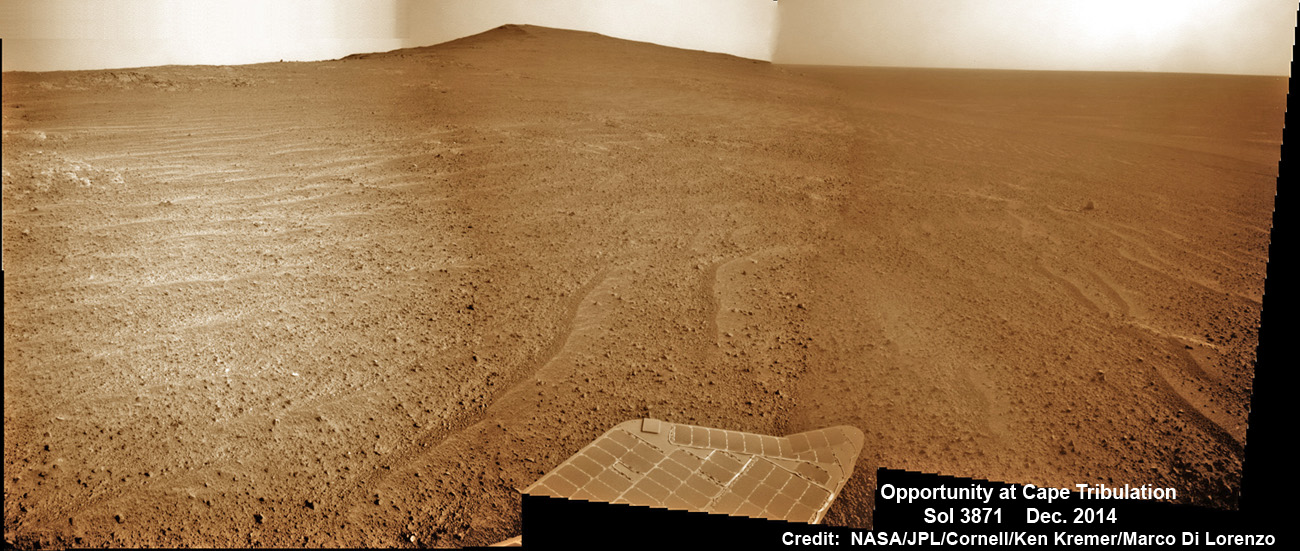
The longest living Red Planet rover ever crafted in human history is about to accomplish another astounding feat along her astonishing 11-year trek across the most Earth-like planet in our Solar System.
NASA’s Opportunity rover is within reach of the summit of Cape Tribulation, heading southwards along gigantic Endeavour crater—and it counts as the highest Martian mountain she will ever scale in her unbelievably incredible and momentous life of exploration and discovery.
“Opportunity will stay a few sols (or Martian days)” at the summit spot called “Summit Lithology,” Prof. Ray Arvidson, the rover Deputy Principal Investigator of Washington University told AmericaSpace exclusively today.
Opportunity is now at an elevation of some 1,380 meters!
What does the peak of Cape Tribulation look like?
“We are currently sitting on the slope extending westward from [Endeavour crater] rim rocks, an area that looks very much like a sediment shaped by wind. Thin soil cover, with cobbles, over bedrock.”
And check out the summit firsthand with our brand new mosaic view herein, created for AmericaSpace by Ken Kremer and Marco Di Lorenzo.
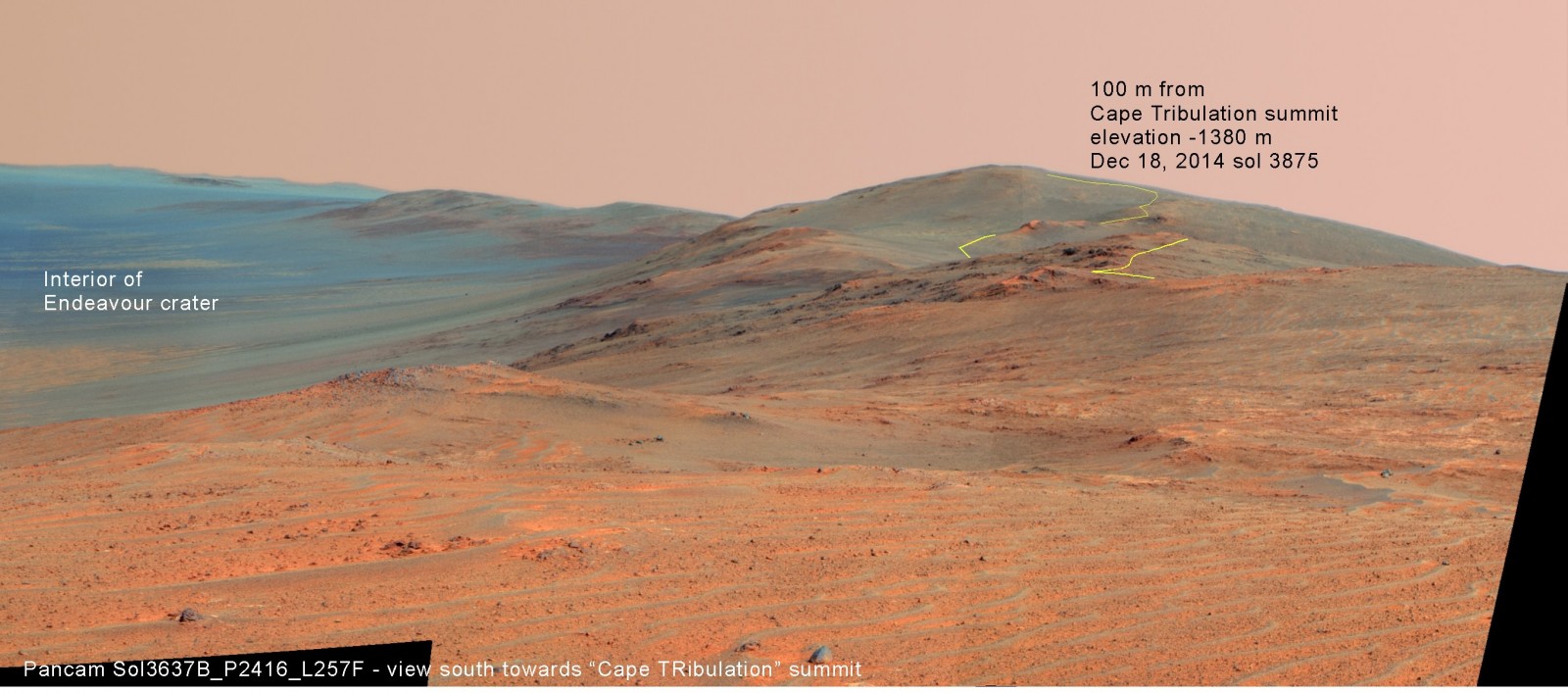
Arriving at Cape Tribulation has been a long-sought goal of the science team because it puts the six-wheeled rover in a region of clay minerals that’s a scientific goldmine, since they formed in neutral liquid water billions of years ago when the Red Planet was far warmer and wetter and thus much more conducive to the formation of Martian microbes, if they ever existed.
At the summit, Opportunity will perform some important science observations and then march onward to the clay minerals.
“One more key science target before then and that is a last set of measurements on the Shoemaker formation breccias, at a stop called summit lithology,” Arvidson elaborated.
The ancient, weathered slopes of Cape Tribulation hold a motherlode of the “phyllosilicate” clay minerals, based on data obtained from the extensive orbital measurements made by the CRISM spectrometer, accomplished earlier at the direction of Arvidson.
The clay minerals were detected from orbit by the CRISM spectrometer aboard NASA’s powerful Martian Spysat—the Mars Reconnaissance Orbiter (MRO)—while gathering context data at rock outcrops along the long and winding way over the past few years.
The robot’s science team specifically directed Opportunity toward Cape Tribulation several years ago, based on the detection of abundant exposures of aluminum-rich clay minerals at a spot a bit beyond the summit, called “Marathon Valley,” using the spectral measurements from CRISM and MRO.
“Opportunity remains only a few sols at the summit lithology before going to Marathon Valley,” Arvidson stated.
“Today, we are about 500 meters from ‘Spirit of Saint Louis’ crater at the entrance to Marathon Valley (named because the rover will have traveled one marathon’s distance to reach it)!”
As of today, the rover is less than 100 meters’ drive from Tribulation’s summit, according to rover science team member Larry Crumpler of the New Mexico Museum of Natural History & Science (NMMNHS), in an update.
“The outcrops are few and far between up here, but so far all of the outcrops along the rim have been impact breccias. Some are more altered than others. The devil is in the details,” says Crumpler.
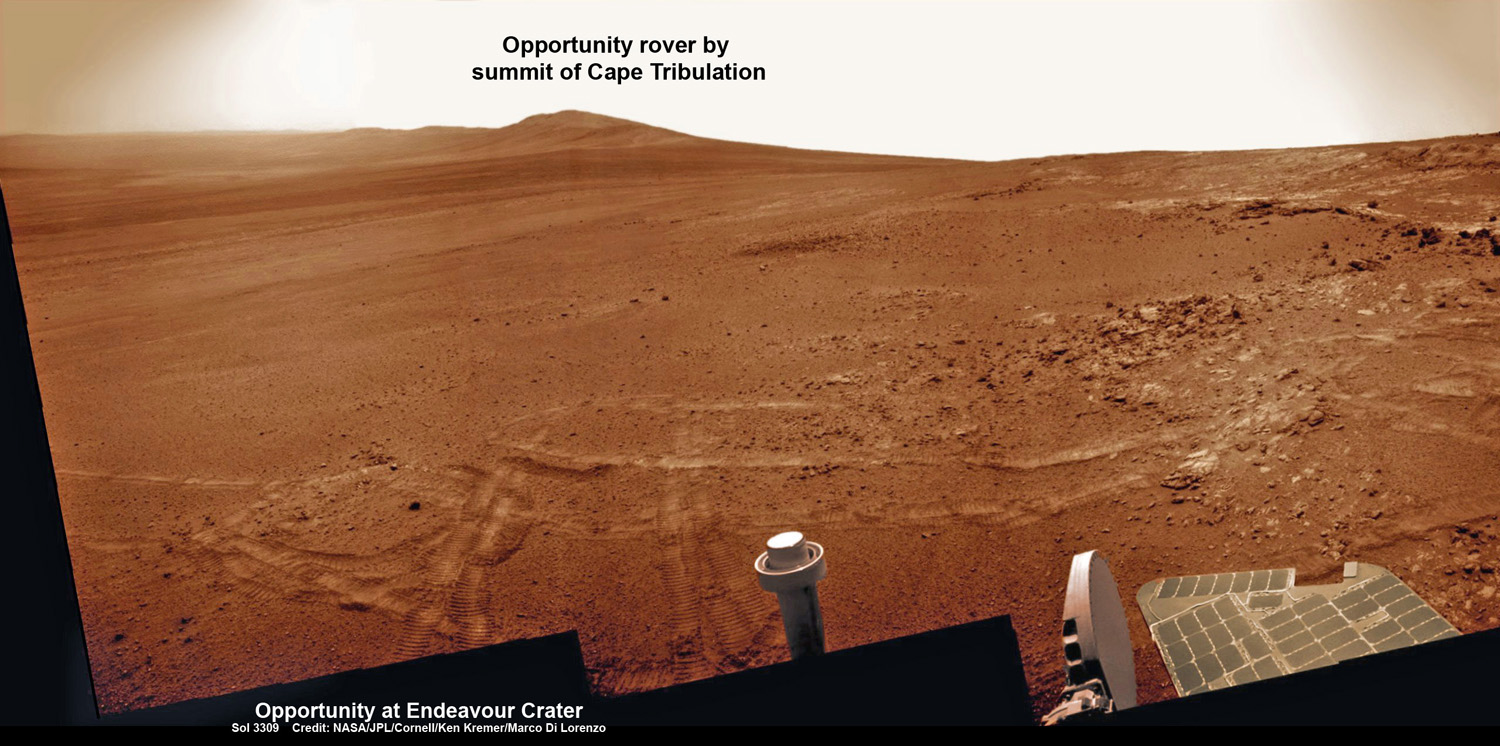
The superlatives are never ending for the world-famous and world-renowned Opportunity Mars Exploration Rover (MER), as she not only climbs to the peak of her tallest mountain but also is now less than one month away from celebrating her 11th year driving about the surface of Mars.
And the view from the summit promises to be spectacular, looking back into the vast expanse of Endeavour crater from atop the eroded and tall rim segment at Cape Tribulation.
The navcam and high-resolution pancam cameras will gather superlative views.
“The panoramic view from that summit should be awesome. Mid summer [in Mars southern hemisphere] is only a few sols away,” says Crumpler.
“In the next few drives it will be at or near the highest peak along the rim, Cape Tribulation summit. At that point Opportunity will be as high in elevation on Mars as it will ever be.”
Endeavour crater is indeed humongous, spanning some 22 kilometers (14 miles) in diameter, and Opportunity will likely spend the remainder of her robotic life traveling around and investigating its magnificent and vast expanse.
Opportunity finally arrived at Endeavour’s western rim crater in August 2011, at a rim segment named “Cape York,” after a multi-year traverse across the plains of Meridiani Planum.
“She began a whole new mission at Endeavour” as Prof. Steve Squyres, Science Principal Investigator of Cornell University, likes to say.
Opportunity has been mostly driving in a southerly direction from Cape York to Cape Tribulation, with numerous science stops along the way.

“The geology really gets wild at “Marathon Valley,” says Crumpler.
“Arrival may be March or as late as July 2015. We hope to get there way before next Mars winter so we will have plenty of time to check things out.”
What’s the expected view and terrain at Marathon Valley?
“Lots of interesting outcrops and north facing slopes expected for Marathon Valley,” Arvidson explained to AmericaSpace.
By traversing north-facing slopes in Mars’ southern hemisphere, the robot keeps her solar arrays pointing advantageously to the Sun to maximize power generation to keep all her systems running longer and longer.
Since it was the long-term goal and its loaded with rich deposits of clay minerals, how long will Opportunity remain at the outcrops? Will it be the site of the next Martian winter campaign?
“Opportunity will be at Marathon Valley a long time, probably through the next winter!” said Arvidson.
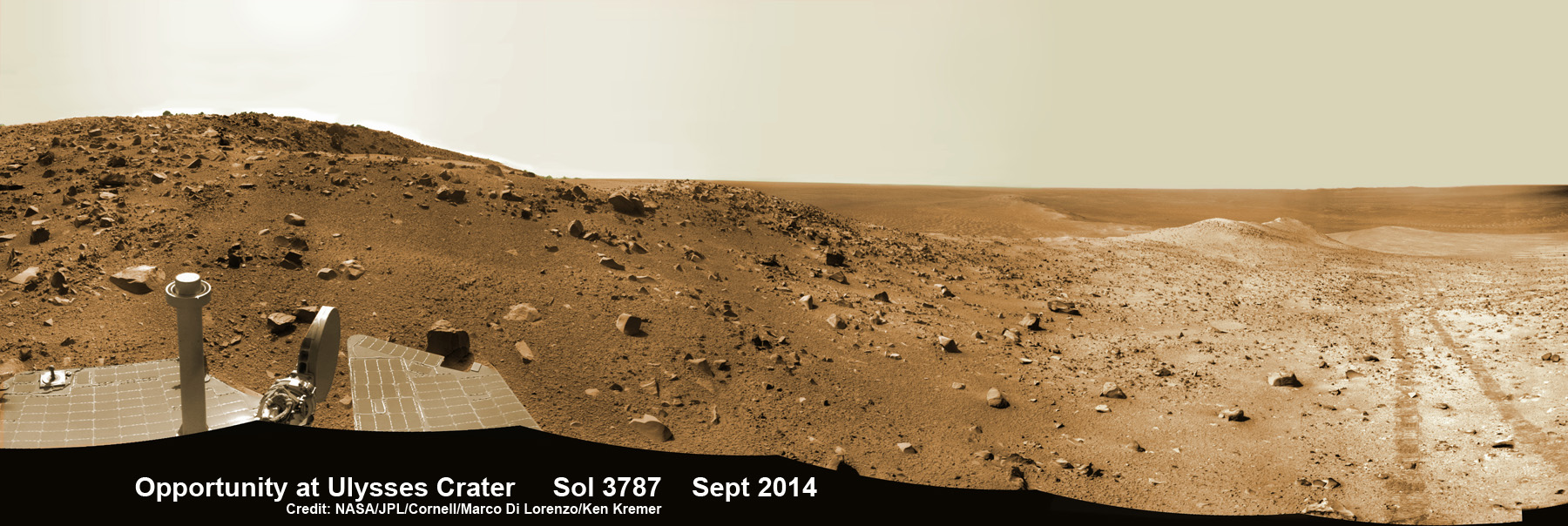
Today, Dec. 27, marks Opportunity’s 3884th Sol, or Martian Day, roving Mars. She has snapped over 199,400 amazing images since her air-bag assisted touchdown on Jan. 24, 2004, inside Eagle crater.
She was expected to last a mere three months—with a “warranty” of 90 Sols. That’s an unbelievable 43 times beyond her expected warranty. It’s like we launched 43 rovers to explore the Red Planet for the price of one rover launch, way back in the summer of 2003.
Opportunity’s total odometry is 25.73 miles (41.42 kilometers).
She recently surpassed another interplanetary record for distance driving on another world—exceeding 41 kilometers on Sol 3837 (Nov. 9, 2014).
The robot has sufficient power for the exciting, upcoming research endeavors, comprising her ground-breaking science expedition, following a series of fortuitous wind cleaning events earlier in the year that substantially cleared the dust off the power generating solar wing arrays.
The solar array energy production currently stands at 494 watt-hours, compared to about 900 watt-hours at landing in 2004 and only about 270 watt-hours just before Christmastime in December 2013.
The mineral-rich mountain caches of Marathon Valley at Cape Tribulation lie just ahead.
And this past Oct. 19, Opportunity accomplished astroimaging of the Oort Cloud comet Siding Spring during its close-by of Mars.
Meanwhile, younger sister Curiosity is surveying and drilling into the foothills of another truly enormous Martian mountain on the opposite side of the Red Planet, called Mount Sharp.
And scientists just announced Curiosity’s discovery of methane, organic molecules, and a lake inside the Gale crater landing site. Read all about it here and here.
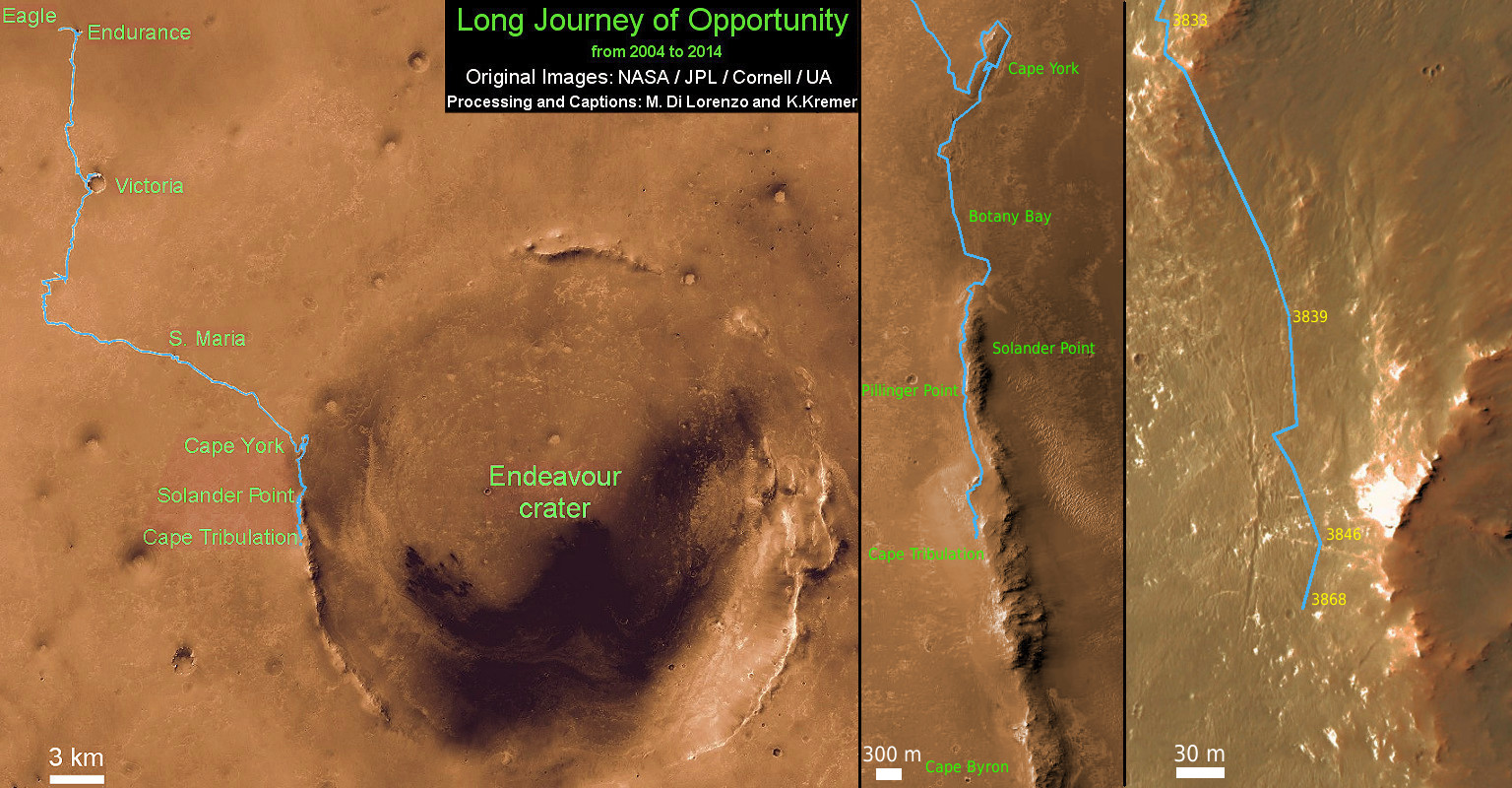
Stay tuned here for continuing developments.
Want to keep up-to-date with all things space? Be sure to “Like” AmericaSpace on Facebook and follow us on Twitter: @AmericaSpace
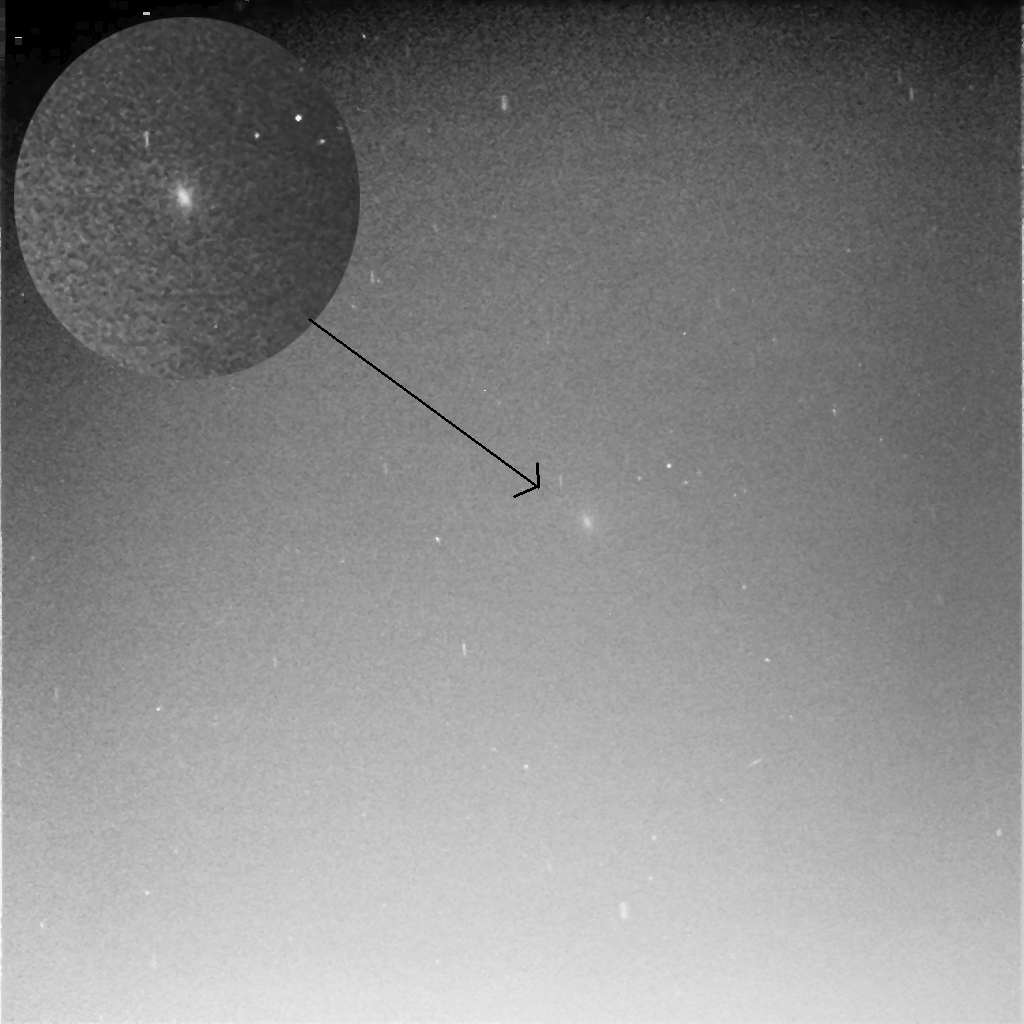




space missions have come a long way from when I first watched America send Alan shepherd up into space and his quick return. what I would like to know, who gives the names to the valleys, craters, mountain peaks. I wish to thank all you for not only continuing with planet missions but as well landing on a comet to bring back those precious pictures. I have and will follow NASA in its continued spce probes
There are not enough superlatives to describe Opportunity or the scientists, engineers and support staff who have made this mission possible. Opportunity stands as a monumental achievement in planetary exploration.